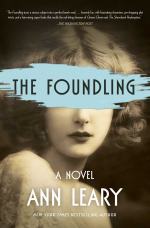|
This section contains 839 words (approx. 3 pages at 400 words per page) |

|
The Foundling Summary & Study Guide Description
The Foundling Summary & Study Guide includes comprehensive information and analysis to help you understand the book. This study guide contains the following sections:
This detailed literature summary also contains Quotes and a Free Quiz on The Foundling by Ann Leary.
The following version of this book was used to create the guide: Leary, Ann. The Foundling. Simon and Schuster, 2022. Kindle Edition.
The Foundling is a work of historical fiction set in the beginning half of the twentieth century that tells the tale of an institution that was created to house women of childbearing age who were believed to have either intellectual, psychological, or moral defects that would make any children they produce a financial strain on society. By locking the women away during their childbearing years, the Village attempts to stop this procreation. The outside world believes that the women being detained cannot take care of themselves and that they have all been thoroughly tested before being admitted into the Village. There is a long waiting list of women whose loved ones want them admitted. Often it is men who seek out the admittance for the women in their lives.
Mary Engle first hears about the Village when her teacher recommends her for a job to Dr. Vogel, the head administrator of the Village. Mary goes to a speech Dr. Vogel gives and is instantly impressed with the woman. Dr. Vogel believes strongly in eugenics and believes that moral depravity can be inherited. Thus by stopping people whom she believes have deficient morals from procreating, those immoral genes cease to be passed on.
Mary grew up at St. Catherine’s, a home for children without parents. Mary’s father is alive, but she cannot live with him because of the nature of the work he is involved in. Eventually she learns that he was involved in criminal activities, but she does not learn this until many years later. Most of the girls at the home love Sister Rosemary, a sister at the facility, as does Mary, and Mary stays in touch with the nun through her adult life.
While at St. Catherine’s, Mary was sexually abused by her Uncle Teddy when he took her out on drives to see her father. Uncle Teddy makes her afraid to tell anybody about the abuse, so the only person she tells is her friend, Lillian. Lillian helps her cope with the trauma by helping her get money from Uncle Teddy and turning this into a game. One day Mary gets Uncle Teddy extra drunk so that he cannot assault her, and she puts his car into gear when he is passed out, so the car will get stuck in some muck. The car veers, however, and he dies. Lillian is the only person who knows about Mary’s role in the accident.
The novel begins when Mary is an adult, and most of Mary’s time at St. Catherine’s is told through either conversations or through memories. When Mary meets Dr. Vogel, the woman offers her a job right away, and Catherine leaves for the Village. She originally lives with the Goodwin family on the Village property and acts as a secretary for Miss Hartley rather than Dr. Vogel. One day Bertie, a friend of Mary’s who works in the infirmary, comes in and tells Dr. Vogel about a woman who has been raped, Ida. Ida is one of numerous women who are sent out to work in the world and whose wages are paid to the Village. Dr. Vogel and Mary go to tell the banker, Witcomb, that they are going to report him, but because of his financial generosity, Dr. Vogel ultimately decides not to report the crime. She makes Mary her secretary.
Mary comes to learn that Lillian is a resident at the Village. Lillian asks Mary for help, but at first, Mary refuses to help her. Lillian reminds Mary too much of her uncle, and she has tried to block her from her memory ever since leaving St. Catherine’s. Lillian was sent to the Village by her husband when Lillian’s baby was born Black. Lillian was already afraid of her husband because he raped her before they were married, but she married him and planned to escape before the baby was born. She was sent to the Village because the baby was born too early for her to set her plan into action.
Eventually Mary realizes that Lillian should not be at the Village, and she tries to help her win her freedom. When that fails and Lillian ends up in Building Five, a place used as a punishment against women, Mary breaks Lillian out with the help of numerous other employees of the Village. When Lillian is non-fatally shot in this attempt, Mary helps Lillian fake her death. Mary goes back to the Village and shows some members of the Board of Trustees and others the abominable conditions in Building Five. Dr. Vogel resigns, and Lillian and her daughter, Rosemary, plan to go live with Rosemary’s father, Graham. Mary marries a man named Jake who helped in Lillian’s escape. Conditions at the Village improve, but it is still in existence at the end of the novel.
Read more from the Study Guide
|
This section contains 839 words (approx. 3 pages at 400 words per page) |

|



